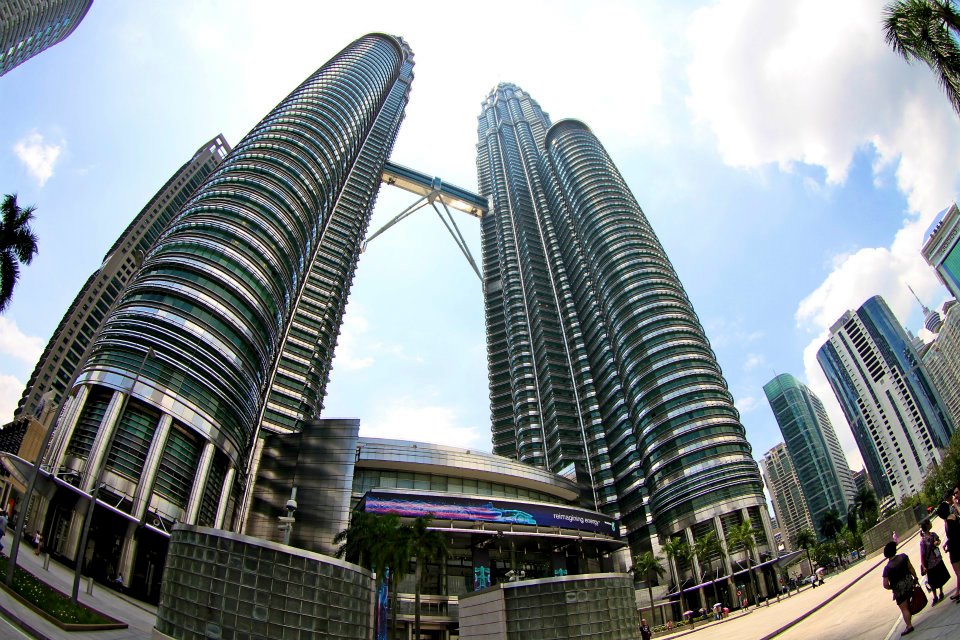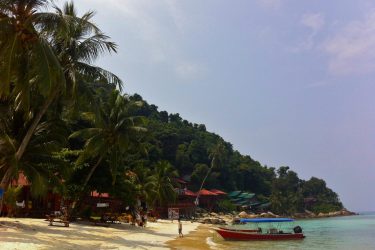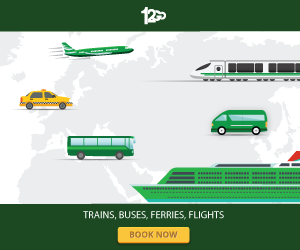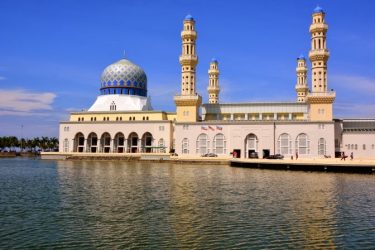Traveling to Malaysia is a sensory adventure through a nation that skilfully combines modern urbanization, lush landscapes, and a diversity of cultures. The dynamic capital of Malaysia, Kuala Lumpur, is home to well-known sites such as the Petronas Towers, which represent the country’s economic might, and Chinatown’s humming street markets, which highlight the city’s diverse past.
The UNESCO-listed island of Penang welcomes visitors to explore its historic George Town, which is well-known for its colonial architecture, colorful street art, and varied gastronomic scene. With its charming scenery, cold mountain air, and tea plantations, the Cameron Highlands provide a rejuvenating getaway.
Malaysia’s tapestry of cultures represented in its holidays, like the vivid Chinese New Year celebrations that envelop the nation in crimson and gold, and the colorful Thaipusam, which celebrated with majesty in Batu Caves.
With its blue waters and lush tropical surroundings, Langkawi’s immaculate beaches offer the perfect environment for leisure and water sports. Borneo’s verdant jungles, home to pygmy elephants and orangutans, are home to a variety of unusual species.
Foodies will enjoy the combination of Malay, Chinese, Indian, and indigenous flavors found in Malaysia’s diverse cuisine. Discovering lush landscapes or urban jungles, Malaysia greets guests with a plethora of cultural experiences and kind hospitality. In this article, we will give you the best things to do and see in Malaysia when you visit..
Visit the Island of Penang in Malaysia
Known as the “Pearl of the Orient,” Penang is a fascinating Malaysian island that skillfully combines a rich past, a plethora of cultural traditions, and contemporary appeal. George Town, the lively capital of Penang and a UNESCO World Heritage Site, sits at the center of the island. This city is a live example of how Chinese temples, Indian mosques, Malay timber homes, and British colonial architecture all came together to create a very beautiful urban tapestry.
Visitors can see fascinating street art murals, interactive exhibits, and quaint cafes while meandering around George Town’s streets. A collection of stilted water cottages called the Clan Jetties provides a window into the island’s heterogeneous origins and seafaring past.
With its lively hawker booths offering a wide variety of foods influenced by Malay, Chinese, Indian, and Peranakan flavors, Penang is a food lover’s paradise. Penang is a culinary haven for those looking for delicious food, and the Penang Street Food Festival honors the island’s culinary legacy.
Beyond the city, Penang’s natural splendor can be seen in locations like Penang Hill, which provides sweeping views of the entire island, and Penang National Park, a tropical haven with immaculate beaches and verdant rainforests. The Island of Penang invites visitors to discover the spirit of Malaysia’s cultural diversity with its wealth of historical significance and modern energy.
Beach Resorts in Malaysia
Malaysia is home to many beach resorts that provide the ideal fusion of opulence, scenic beauty, and cultural diversity. Resorts like The Datai and Four Seasons Langkawi are located in the tropical paradise of Langkawi, tucked away between immaculate beaches and beautiful woods. These resorts offer a tranquil haven with access to the island’s most exciting attractions as well as first-rate amenities and stunning views.
Redang Island, located on Peninsular Malaysia’s east coast, is well-known for its coral reefs and crystal-clear waters. In the midst of picturesque surroundings, the Taaras Beach & Spa Resort and Sari Pacifica Resort & Spa radiate elegance and provide visitors with the chance to enjoy both relaxation and underwater activities.
Resorts like Bubu Resort in Perhentian Besar found in the Perhentian Islands, which known for its white sand beaches and colorful aquatic life. These resorts offer a cozy yet rustic ambiance that lets visitors unwind and take in the islands’ natural beauties.
Resorts like Berjaya Tioman Resort and Japamala Resort are located on Tioman Island, off the east coast. The perfect combination of beachside pleasure, tropical scenery, and recreational opportunities found at Malaysia’s beach resorts, which are a refuge for anyone looking for an opulent and immersive coastal escape.
Visit Kuala Lumpur, Malaysia
Malaysia’s vibrant capital, Kuala Lumpur, is a modern city where tradition and modernity coexist. A testament to Malaysia’s economic development, the Petronas Towers dominate the city’s renowned skyline. Beneath these, imposing buildings is a city that masterfully combines a variety of cultures, delectable food, and breath-taking architecture.
Situated amidst stately Sultan Abdul Samad Building and colonial-era buildings, Merdeka Square is a testament to Malaysia’s independence. Areas like Chinatown and Little India, where bustling marketplaces, mosques, and temples live peacefully, are good examples of Kuala Lumpur’s cultural variety.
Bukit Bintang is a shopping haven for aficionados, renowned for its posh shops, entertainment centers, and vibrant nightlife. In the middle of the city, KLCC Park, which is next to the Petronas Towers, offers a calm green area.
With street food vendors, hawker centers, and upscale eateries serving a blend of Malay, Chinese, Indian, and Western flavors, Kuala Lumpur’s culinary scene is a culinary journey. Kuala Lumpur is a fascinating location that skillfully blends history and modernity thanks to its vibrant environment, diverse culture, and amazing architectural feats.
Visit Batu Caves in Malaysia
Situated in the outskirts of Kuala Lumpur, Malaysia, Batu Caves is a captivating collection of limestone caverns and cave temples surrounded by towering limestone hills. The location is well-known for its religious significance, breathtaking scenery, and lively cultural events.
The magnificent golden figure of Lord Murugan, which is the centerpiece of Batu Caves, is among the largest Hindu statues in the world. It stands at 42.7 meters (140 feet) in height. During the yearly pilgrimage season, travelers must mount a steep flight of 272 colorful stairs to reach the caves, which surrounded by the vivid hues of the Thaipusam Festival.
Numerous Hindu shrines and temples, each with elaborate carvings and statues honoring different deities, are located within the caverns itself. The Cathedral Cave has a regal ambiance because to its skylight and high ceiling.
In addition to being an important religious location, Batu Caves has a network of caverns and limestone formations that beg to be explored. The location offers travelers to Malaysia a singular and immersive experience because of its unique blend of spirituality, scenic beauty, and cultural vibrancy. It is a must-visit location.
Take the Langkawi Cable Car in Malaysia
Visitors may have an amazing airborne experience as the Langkawi Cable Car, also known as SkyCab, takes them to the summit of Mount Machinchang on Malaysia’s Langkawi Island. This cable car ride is a thrilling way to take in the island’s natural splendor, offering panoramic views of the surrounding hills, jungles, and the Andaman Sea.
One of the steepest cable car systems in the world provides the 15-minute ride to the summit. The verdant scenery opens up as the gondolas ascend, offering a visual feast of waterfalls, dense tropical vegetation, and the blue Andaman Sea waters.
Awaiting you at the top is the stunning curved Langkawi SkyBridge, which is 700 meters above sea level. This architectural wonder provides expansive views of the nearby islands and geological formations, making it an ideal spot for taking pictures and appreciating the variety of ecosystems in Langkawi.
The Langkawi Cable Car offers not only an exhilarating experience but also a chance to discover the distinctive flora and fauna of the area. The ride is a must-see attraction for those looking for adrenaline and the opportunity to fully experience Langkawi’s natural treasures and the breath-taking scenery only serve to enhance the experience.
Go on the North Borneo Steam Railway
Travelers can take a trip down memory lane on the North Borneo Steam Railway, which provides a classic rail experience through the stunning scenery of Sabah, Malaysian Borneo. Using meticulously restored steam engines and carriages from the British colonial era, Sabah State Railway runs this heritage railway, bringing back the allure of bygone eras.
The steam train travels through vibrant local communities, deep jungles, and rural countryside as it leaves Tanjung Aru, which is close to Kota Kinabalu. Teakwood panelling and big windows provide passengers unhindered views of the surrounding splendor of the immaculately restored carriages.
The beautiful run along the shore, which offers views of the South China Sea and the majestic Mount Kinabalu in the distance, is the highlight of the trip. The rhythmic chugging of the steam locomotive and the nostalgic atmosphere creates an engrossing experience that perfectly depicts the romanticism of rail travel.
In addition to providing a lovely journey through Sabah’s sceneries, the North Borneo Steam Railway sheds light on the region’s colonial past and the significance of rail transit in the early 20th century. This steam train offers a ride full of charm, history, and breath-taking scenery for enthusiasts and those looking for a different way to experience Borneo.
Visit the Sepilok Orangutan Rehabilitation Centre
Located in the heart of Sabah, Malaysia’s Bornean rainforest, the Sepilok Orangutan Rehabilitation Centre is a well-known sanctuary devoted to the preservation and healing of injured and orphaned orangutans. It was founded in 1964 and has been essential to the survival of these threatened monkeys.
Before returning orphaned orangutans to the wild, the center offers them a safe refuge and teaches them vital survival skills in a controlled setting. During the feeding times, visitors get the unique chance to watch these clever animals swinging among the trees while consuming a diet of fruits and milk.
The Bornean Sun Bear Conservation Centre, which focuses on the preservation of the tiniest bear species worldwide, is also located in Sepilok. In order to safeguard and sustain its declining population, the sun bear, sometimes referred to as the “honey bear,” benefits from educational initiatives and rehabilitation programmes.
This sanctuary teaches tourists about the value of rainforest conservation in addition to providing up-close encounters with orangutans and sun bears. Nestled in the middle of Borneo’s rich and diverse ecology, the Sepilok Orangutan Rehabilitation Centre serves as a ray of hope for the future of these amazing primates. It encourages environmental responsibility and awareness.
Visit the Cameron Highlands in Malaysia
Nestled in Malaysia’s Titiwangsa Mountains, the Cameron Highlands is a tranquil and scenic area well-known for its temperate weather, expansive tea plantations, and verdant surroundings. This highland sanctuary, tucked away at a height of about 1,500 meters above sea level, provides a cool respite from the sweltering heat.
The area, with its lush slopes, mossy forests, and colorful flower displays, is a sanctuary for nature lovers. Cradled between gnarled tree trunks and thick layers of moss, the Mossy Forest is a must-visit for those seeking an otherworldly experience because of its mysterious atmosphere and distinctive flora.
The vast tea plantations in the Cameron Highlands are one of its distinguishing characteristics. In particular, the Boh Tea Plantation welcomes guests to experience the tea-making process, have freshly brewed tea, and take in expansive vistas of verdant mountains.
Butterfly farms, strawberry farms, and flower nurseries enhance the area’s agricultural beauty. The Cameron Highlands’ cool environment also makes it a great place to go hiking, waterfall exploring, and outdoor recreation.
For those looking for a peaceful getaway and a way to connect with Malaysia’s breath-taking highland scenery, the Cameron Highlands provide a serene blend of natural beauty, agricultural charm, and a cool mountain environment.
9. Visit Kota Kinabalu in Malaysia
The capital of the Malaysian state of Sabah, which is located on the island of Borneo, is Kota Kinabalu, sometimes known as KK. Situated between the South China Sea and the verdant Tunku Abdul Rahman National Park, Kota Kinabalu offers an enthralling fusion of contemporary design and unspoiled landscapes.
The city is well known for its breathtaking sunsets, and tourists frequently swarm to the “Kota Kinabalu City Mosque” waterfront area to take in the magnificent vistas. Every Sunday, the lively Gaya Street Market comes alive with a bustling environment that welcomes both locals and visitors to peruse shops selling anything from handicrafts to fresh fruit.
The biodiverse Kinabalu Park, a UNESCO World Heritage Site, and the beautiful Mount Kinabalu, Malaysia’s highest peak, are only two of the diverse ecosystems of Sabah that may be explored from Kota Kinabalu. Adventure seekers can go on cultural exchanges with the local indigenous populations, enjoy water sports, and explore the neighbouring islands.
Atkinson Clock Tower, the Sabah Museum, and the Sabah State Mosque are just a few examples of the city’s many cultural icons. For those looking for a harmonious fusion of urban and natural experiences in Southeast Asia, Kota Kinabalu is a compelling destination due to its friendly hospitality, delicious seafood, and status as a hub for ecotourism.
10. Festivals in Malaysia
Malaysia is a multicultural nation that celebrates a wide range of festivals all year long, each of which reflects the rich diversity of customs and religious beliefs that exist there.
Chinese New Year is a bright and well-known holiday that celebrated with lots of lanterns, dragon dances, and colorful parades. Families get together for reunions and the streets come alive with celebrations as people welcome the lunar New Year with happiness and prosperity.
The end of Ramadan, Hari Raya Aidilfitri, is a major Muslim holiday marked by feasts, open houses, and a sense of reconciliation and forgiveness. Traditional Malay treats shared among friends and neighbors while the streets decked out with lights.
The Hindu Festival of Lights, Deepavali, also known as Diwali, observed with the lighting of houses, elaborate kolam artwork, and lively cultural events. The celebration honours the victory of good over evil and light over darkness.
Thaipusam is a Hindu holiday honoring Lord Murugan that celebrated with intricate body piercings, vibrant processions, and acts of devotion. On their spiritual journey, pilgrims frequently carry kavadis decorated with flowers.
Among other events, these festivals highlight Malaysia’s unity in diversity as people from different ethnic backgrounds together to celebrate and pay tribute to their cultural heritage, promoting inclusivity and harmony in this country in Southeast Asia.

















